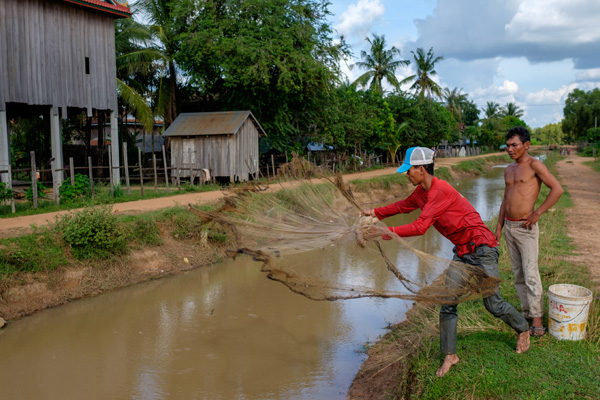
Staying Afloat
How Cambodia’s erratic water conditions make it the perfect pilot for the Sustainable Water Partnership.
If you travel to Cambodia’s Tonle Sap basin, you might see flooded fields full of what look like reeds, foliage waving above the surface of the water. While it may not look like much, it’s actually rice — “floating” or “deepwater” rice. Flooding is a fact of life near the constantly rising and falling Tonle Sap lake, but that’s not a problem for this resilient crop. Its stem elongates as the water rises, and as long as the flooding happens gradually, the rice keeps its head above water.
The Cambodian people living near the Tonle Sap, like the rice they grow, have adapted to their ever-fluctuating environment. Over centuries, local farmers have learned to plant their crops at the end of June, just after the first rain of the annual monsoon, and harvest just before the dry season begins. Even the houses near the lake, built on stilts towering high above the water line, show their inhabitants’ preparation for the water’s rise and fall.
“The water level in the lake has always been going up and down. They are used to that,” says Sustainable Water Partnership (SWP) Director Eric Viala, who visited Cambodia late last year. “They adjust their livelihood activities to the conditions.”
But over the last few decades, those conditions have begun to change. Population growth is forcing families into more dangerous, flood-prone areas, where traditional coping mechanisms are less effective. And with climate change and variability on the rise, seasonal events which were once dependable — the timing of the monsoon, the lengths of the dry and wet seasons — are no longer a given. If farmers wait for the late monsoon to plant, their crops suffer the effects of an abbreviated wet season, spending the crucial last stage of their growth dying of thirst. But if they plant too early, heavier flooding might drown their crops.
“The crops used to be reasonably resilient, but now the rain comes later and harder, the flood rises faster,” says Viala. “Now that the conditions are changing, the people don’t know how to adjust.”
That’s why SWP launched its first pilot project in Cambodia’s Stung Chinit river catchment, which flows into the Tonle Sap basin. But it’s not as though a water project can make the monsoon come on time, or lengthen the wet season – so what can SWP do to help Cambodia’s farmers? According to Viala, “if you can’t change the weather, you have to change mindsets and behaviors.”
One pervasive but misguided approach is the inclination toward infrastructure. Provincial or government groups might build dams, storing water during the monsoons to be released later.
“It’s not really a bad solution, but it’s not good enough,” says Viala. “By changing the flows of the rivers, you’re going to impact people downstream.” For example, an upstream dam leaves fishing communities downstream with less to catch, severely hampering their livelihoods opportunities. And of course, there are aspects of Cambodia’s erratic water conditions that infrastructure just can’t solve. “At the end of the day, a dam is not going to address pollution, or the fact that, due to population growth, people build houses or grow crops in areas that are flood-prone,” Viala says.
There’s also a need for behavior change when it comes to the application of pesticides and fertilizer. “People think if you use more chemicals, then the yield is going to increase. But if you put too much chemicals on your crops, at some point the crop is not going to like it,” Viala explains. “And even if the crop likes it, you’re probably going to endanger the people who eat those crops.”
That’s where SWP comes in, offering trainings and guidance on agricultural best practices: how much water each plant needs, where and when to plant which crops, how much fertilizer and pesticide to use.
These and other solutions were part of the discussion at the project’s recent national and provincial launch workshops. Stakeholders from all levels, from the director of Cambodia’s Ministry of Water to provincial delegates, gathered to talk about the area’s needs and brainstorm answers. The launch events were only the first step in SWP’s Cambodian interventions, but Viala believes SWP will play a crucial role in improving water security near the Tonle Sap.
“There was an awareness [among attendees] that behaviors have to change, and that communities and the government need to work together,” he says. “We are off to a good start.”
This post originally appeared on the Sustainable Water Partnership website.
Related Projects

